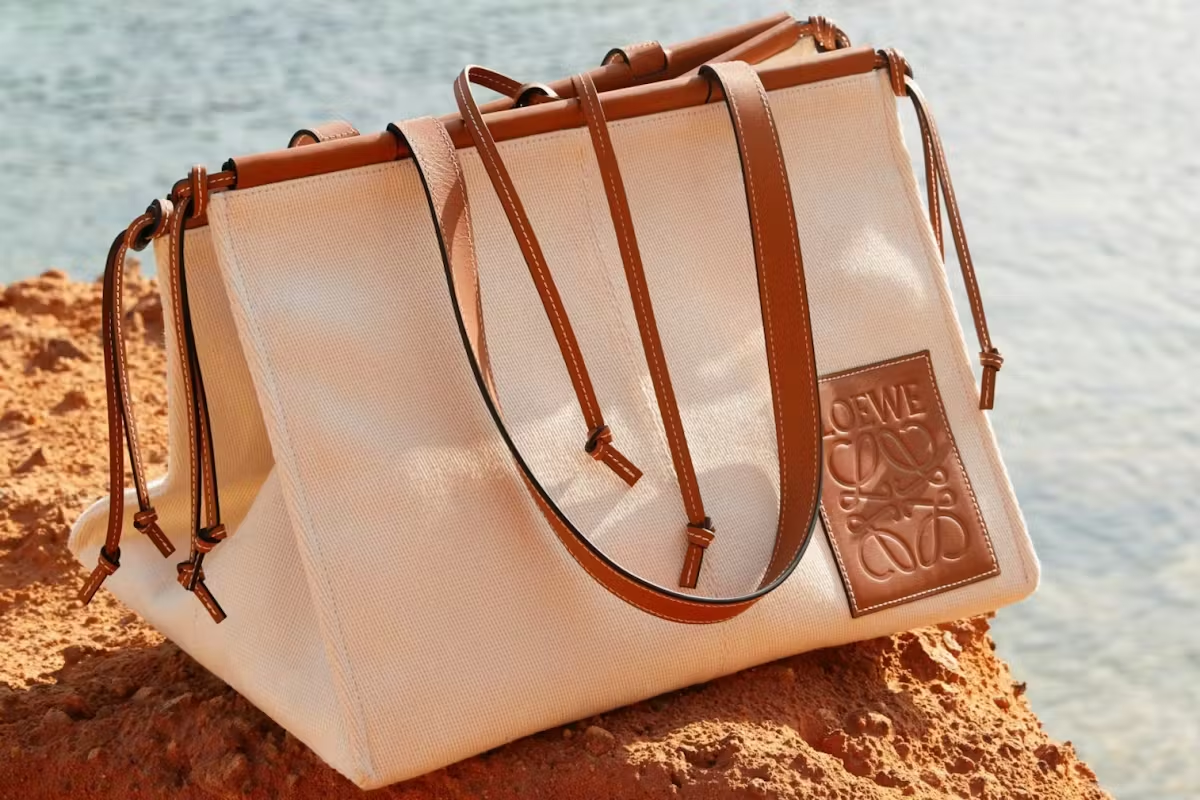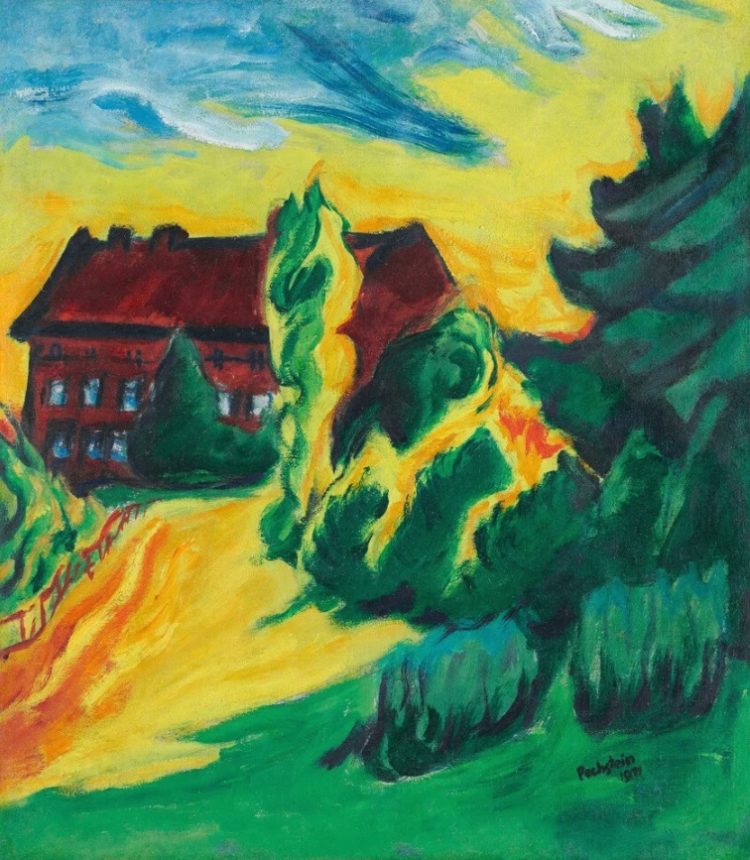Craving nature and inspiration, Max Pechstein (1881-1955) arrived in Leba on the Baltic coast of what was then the German province of Pomerania in the spring of 1921, taking rooms at the Gasthof Möller. For his wife, Lotte, and their young son, Frank, it was a holiday, a break from the bustle of Berlin. For Pechstein it was an epiphany. “The new landscapes, the new people, I gorged myself upon them,” he wrote. The watery terrain, intense colours and glittering light seemed to him a European approximation of the tropical landscapes that had captivated him seven years earlier. Inspired by Gauguin’s paintings of Tahiti and the Marquesas, as well as the Oceanic wood carvings he had seen in Dresden’s Museum of Ethnography during his student days, he spent four months in Palau, a remote archipelago of tiny islands in Micronesia in the Western Pacific that was then a German colony.
But Pechstein’s time in Palau was cut short by World War One, and Japan’s seizure of the islands in 1914. Pechstein was deported to Nagasaki and made his way home via New York, working as a coal trimmer on a steamer to secure a transatlantic crossing. Back in Germany, he enlisted in the army, serving on the Western Front and latterly as an aerial photography analyst in the Flying Corps.
Returning to Berlin in 1917 to resume his career as an artist, he drew on his memories of Palau, basing his paintings on the sketches he had made. As his biographers Bernhard Fulda and Aya Soika note in Max Pechstein: The Rise and Fall of Expressionism, perhaps the definitive English-language account of his life, he was producing “landscapes dominated by the lush green of tropical vegetation, the dark blue of the Pacific and the glowing yellow and red of sand and earth”. They “made for spectacularly colourful compositions”, 130 of them, as well as watercolours, drawings and woodcuts – not least because he needed to repay the advance from his dealer, Wolfgang Gurlitt, that had enabled the trip.
Look at Sonnenflecken (1922), one of the many paintings he made in Leba in the early 1920s, which Bonhams is offering in New York in December, and those Pacific blues, lush greens, the glowing yellow, even the red sand are still clearly in evidence. “I drown everything in colour,” he had written to his friend, the writer and critic Paul Fechter three years earlier. “My brain is filled only with paintings, and the idea of what to paint drives me from one place to the other.” He was, he wrote, “a slave, a tool of art. Only painting still keeps me going. Once it is over, I will certainly collapse.”
Sonnenflecken shows four fishing boats moored in a channel that leads to the Baltic, their sails hoisted to dry. But the focal point is less the blue-hulled boats, their contours thickly outlined in black, than the yellow sun on the water (the title translates literally as sunspots, but more likely alludes to the dappled light), flecked with white and green to reflect the otherworldly emerald, viridian and golden sky. The influence of Van Gogh, whose work he had first encountered in Dresden in 1905 and whom Pechstein called “The father of us all”, is evident, as is that of Gauguin. But Pechstein’s distinctive expressionism, palette, and loose yet dynamic brushwork are very much his own
If his paintings from this period have a fervency about them, this was a time of heightened emotions for him too. Their holiday over, his family went home to Berlin. Pechstein stayed on, painting prodigiously – he was to have three solo exhibitions across Germany that year – impassioned not just by the glorious surroundings, but the beauty of the innkeeper’s 16-year-old daughter, Marta. “I have also fallen for a dark little imp,” he wrote to a friend, Alexander Gerbig, in August. (Pechstein turned 40 later that year.) “There is practically steam coming out of my ears.” He painted her repeatedly. She and her sister, Liese, are the subjects of Evening (1921) in the Saint Louis Art Museum. (You can see the influence of his time in Palau in his mask-like depiction of their faces.) And she is the nude in the red headscarf in Mädchen am Strand (1923), which Bonhams sold in 2005. That painting was made the year of her 18th birthday, when, having divorced Lotte, Pechstein married her. (Lotte later married Marta’s brother, Hermann.) No wonder Pechstein called those first few months in Leba his “rebirth”.
The son of a textile millworker, Max Pechstein was born in December 1881, in Eckersbach, 120km west of Dresden. One of eight children, he was apprenticed at 15 to a house painter. Having passed his journeyman exams, he secured a place at the School for Applied Arts in Dresden, where his work caught the eye of a professor of interior design, who encouraged him to apply to Dresden’s Academy of Fine Arts and train as an artist. Even before he graduated in 1906, winning the Saxon state’s highest award for art, he was working to commissions, not just for paintings, but stained-glass panels and mosaics. And on leaving he was invited by his friends Erich Heckel and Ernst Ludwig Kirchner to join Die Brücke (The Bridge), a group of architecture students turned artists. They hoped their work would be seen as the link to a new emotionally charged, vibrantly colourful Expressionist way of painting, much as Les Fauves were doing in Paris.
Pechstein was consequently keen to see the world, travelling first to Florence, Ravenna and Rome, then on to Paris where he encountered not just more of Gauguin’s work but Cézanne’s and Matisse’s, and recruited Kees van Dongen to Die Brücke. The First World War notwithstanding, his career flourished as he embraced not just landscapes but portraiture, among the best-known of which is arguably Nelly in the San Francisco Museum of Modern Art, a rare portrait from that time of an African woman. Among his early patrons was the property developer Max Cuhrt, who provided him with a studio on Berlin’s Kurfürstendamm in one of the buildings he had recently constructed, and commissioned a number of works, notably striking portraits of his wife and then his 15-year-old daughter, Charlotte Cuhrt (1910), which Bonhams sold this November in London.
By the mid-1930s, there were hundreds of his paintings in public museums across Germany. But following Hitler’s rise to power in 1933 he, like many of his peers, was branded a degenerate by the new Nazi government. (The inventory of Entartete Kunst drawn up by Joseph Goebbels’ Ministry of Propaganda lists 326 of his works, and 16 of them featured in the notorious exhibition in Munich in 1937.) Pechstein lost his position at the Prussian Academy of Arts, was forbidden to paint and was then accused of being Jewish, not least by Emil Nolde, who had been a fellow member of Die Brücke. “As you know I am considered by a certain group as a Jew,” he wrote to his sister Gertrud, “and although I am laughing about this, it is now absolutely necessary that I get hold of proof to the contrary.” Fortunately, he was able to trace his ‘Aryan’ ancestry back to the 16th century, thanks to church records that proved generations of Pechsteins had worked as blacksmiths and armourers. But Berlin still felt unsafe, and he and Marta returned to Leba to live with her mother till the end of the war. Even there, he recalled, “Brown spies were snooping around everywhere.” In 1944, by which time he was 62, he was drafted into the Volkssturm, or national militia, and the following year, he was captured by the Russians and briefly imprisoned.
On his release he returned to Berlin, to find his home and studio burnt out, but the Academy of Applied Arts appointed him chair, and in 1952, the Federal Republic of Germany honoured him with the Great Cross of Merit. He continued to spend summers on the coast, in Usedom, Strande and Amrum, though not in Leba, which had become part of Poland after the war. His marriage to Marta, however, endured to the end of his life.











































